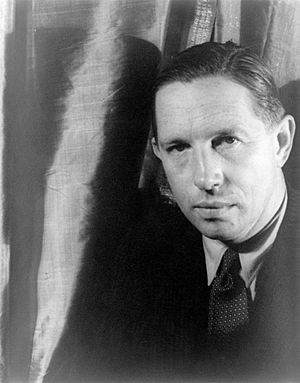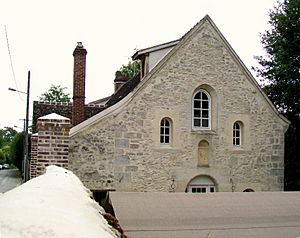Louis Bromfield facts for kids
Quick facts for kids
Louis Bromfield
|
|
|---|---|

Louis Bromfield, photographed by Carl Van Vechten, 1933
|
|
| Born | December 27, 1896 |
| Died | March 18, 1956 (aged 59) |
| Occupation | Writer, conservationist |
| Awards | Pulitzer Prize for the Novel (1927) |
Louis Bromfield (born December 27, 1896 – died March 18, 1956) was an American writer and a champion of nature. He was a very popular novelist in the 1920s. Later, he became a farmer and was one of the first people in the United States to promote sustainable and organic farming.
In 1927, he won the Pulitzer Prize for his book Early Autumn. He also started an experimental farm called Malabar Farm near Mansfield, Ohio. Louis Bromfield played a big part in the early environmental movement, which works to protect our planet.
Contents
Life Story of Louis Bromfield
Early Years and World War I
Louis Bromfield was born as Lewis Brumfield in Mansfield, Ohio, in 1896. His father, Charles, worked at a bank and bought and sold land. His mother, Annette, was the daughter of an Ohio farmer. Later, he changed his name to "Louis Bromfield" because he thought it sounded more important.
As a boy, Louis loved helping on his grandfather's farm. In 1914, he started studying farming at Cornell University. But his family had money problems, so he had to leave after only one semester. His parents sold their house and moved to his grandfather's farm. From 1915 to 1916, Louis tried hard to make the family farm productive again. He later wrote about this tough time in his book The Farm.
In 1916, he went to Columbia University to study journalism. He joined a student group called Phi Delta Theta. He didn't stay long at Columbia. After less than a year, he volunteered to help in World War I with the American Field Service.
Bromfield served in the US Army Ambulance Corps. He helped the French army during major battles in 1918. He was even captured by the German army for a short time.
Becoming a Writer in New York
After the war, Bromfield left the army in 1919. He moved to New York City and worked as a journalist, a critic, and a public relations manager. In 1921, he married Mary Appleton Wood. They had three daughters: Ann, Hope, and Ellen.
In 1924, Bromfield published his first novel, The Green Bay Tree. This book, like many of his others, featured strong, independent female characters. His second novel, Possession, came out in 1925. Important critics praised his early books.
Life in Paris and Hollywood
In November 1925, Bromfield moved to Paris, France. There, he met many famous writers and artists of the time, like Gertrude Stein and Ernest Hemingway. His third novel, Early Autumn, won the 1927 Pulitzer Prize. A critic from the New York Times called him "the best and most vital" of the young American novelists.
Bromfield continued to write popular books in the late 1920s and early 1930s. These included A Good Woman and The Farm. He also worked for a short time in Hollywood as a writer for movies.
Gardens, India, and Helping Others
In 1930, he moved into an old 16th-century building in Senlis, a town north of Paris. He created a beautiful garden there by the River Nonette. He often hosted parties for artists, writers, and famous people. Guests included Gertrude Stein, Alice B. Toklas, and F. Scott Fitzgerald.
Bromfield became more and more interested in gardening. He learned farming methods from his neighbors in Senlis. He also became friends with Edith Wharton, a famous writer who designed gardens nearby.
During this time, Bromfield traveled to India twice. He visited Sir Albert Howard’s soil institute, where he learned about early organic farming. He also stayed with Sayajirao Gaekwad III, the Maharajah of Baroda. His travels inspired his popular book, The Rains Came (1937). This book was later made into a popular movie. He used the money from this book to buy Malabar Farm, saying it was fitting to give the farm an Indian name.
After the Spanish Civil War, Bromfield helped American volunteers who were hurt in the war. He received the French Legion of Honor for this work. He was also against Neville Chamberlain’s policy of appeasement, which he wrote about in his 1939 book England, Dying Oligarchy. He left Europe after the Munich Agreement, planning to move back to Ohio and raise his children on a real farm.
Malabar Farm and Protecting the Land
In December 1938, Bromfield bought 600 acres of worn-out farmland in Ohio. He built a large 19-room farmhouse. With help from government agencies, he restored his land and learned about soil conservation. He turned Malabar into a model farm for what he called the “New Agriculture.” He promoted new farming methods like using green manures, contour plowing, and strip cropping.
In 1941, Bromfield became a leader in the Friends of the Land. This group worked to fix bad farming practices that caused problems like the Dust Bowl. The organization brought together important people in farming and environmental protection. Bromfield used his fame to support agricultural reformers. He also helped make the group's magazine, The Land, popular. It featured articles from famous writers like E. B. White and Rachel Carson.

Malabar Farm became famous in 1945 when Bromfield hosted the wedding of his friends Humphrey Bogart and Lauren Bacall. Bromfield was the best man. Many other celebrities visited Malabar, including James Cagney. A poet named E.B. White wrote about the busy and lively atmosphere at the farm in 1948.
Later Life and Legacy
While Bromfield's interest in farming grew, his writing career became less popular with critics. However, his books still sold very well. His 1947 novel Colorado sold over 1 million copies. He also started writing books about farming and the environment, like Pleasant Valley (1945).
Bromfield faced financial problems because of the high cost of running his experimental farm and his expensive lifestyle. He tried to start other Malabar farms in Texas and Brazil, but they didn't work out. After his wife Mary died in 1952, he became friends with Doris Duke, a wealthy heiress who also loved gardening and conservation. Bromfield died on March 18, 1956, from a serious illness.
After Bromfield's death, Malabar Farm became a state park and a popular place for visitors. Malabar Farm State Park still uses some of Bromfield's ideas about farming. The Doris Duke Woods at the park are named after Doris Duke, who helped save Malabar from being sold after Bromfield passed away.
Many of Bromfield's books about farming are still available today. Farmers and environmentalists like Wendell Berry have said Bromfield was an important influence on their work. In 1989, Louis Bromfield was added to the Ohio Agricultural Hall of Fame. In 1996, a statue of him was placed in the Ohio Department of Agriculture building.
Bromfield's youngest daughter, Ellen Bromfield Geld, continued her father's work in Brazil. She and her husband moved there in 1952 and built a farm. Ellen became a well-known writer and newspaper columnist. She passed away in 2019.
Books by Louis Bromfield
- The Green Bay Tree, 1924
- Possession, 1925
- Early Autumn, 1926
- A Good Woman, 1927
- The Strange Case of Miss Annie Spragg, 1928
- Twenty-four Hours, 1930
- A Modern Hero, 1932
- The Farm, 1933
- The Man Who Had Everything, 1935
- The Rains Came, 1937
- England: A Dying Oligarchy, 1939
- Night in Bombay, 1940
- Wild Is the River, 1941
- Mrs. Parkington, 1943
- Pleasant Valley, 1945
- A Few Brass Tacks, 1946
- Colorado, 1947
- Malabar Farm, 1948
- The Wild Country, 1948
- Out of the Earth, 1950
- Mr. Smith, 1951
- The Wealth of the Soil, 1952
- Up Ferguson Way, 1953
- A New Pattern for a Tired World, 1954
- Animals and Other People, 1955
- From My Experience, 1955
See also
 In Spanish: Louis Bromfield para niños
In Spanish: Louis Bromfield para niños
- List of ambulance drivers during World War I


